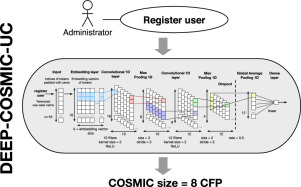Information and Software Technology ( IF 3.8 ) Pub Date : 2020-03-18 , DOI: 10.1016/j.infsof.2020.106310 Mirosław Ochodek , Sylwia Kopczyńska , Miroslaw Staron

|
Context
COSMIC is a widely used functional size measurement (FSM) method that supports software development effort estimation. The FSM methods measure functional product size based on functional requirements. Unfortunately, when the description of the product’s functionality is often abstract or incomplete, the size of the product can only be approximated since the object to be measured is not yet fully described. Also, the measurement performed by human-experts can be time-consuming, therefore, it is worth considering automating it.
Objective
Our objective is to design a new prediction model capable of approximating COSMIC-size of use cases based only on their names that is easier to train and more accurate than existing techniques.
Method
Several neural-network architectures are investigated to build a COSMIC size approximation model. The accuracy of models is evaluated in a simulation study on the dataset of 437 use cases from 27 software development projects in the Management Information Systems (MIS) domain. The accuracy of the models is compared with the Average Use-Case approximation (AUC), and two recently proposed two-step models—Average Use-Case Goal-aware Approximation (AUCG) and Bayesian Network Use-Case Goal AproxImatioN (BN-UCGAIN).
Results
The best prediction accuracy was obtained for a convolutional neural network using a word-embedding model trained on Wikipedia+Gigaworld. The accuracy of the model outperformed the baseline AUC model by ca. 20%, and the two-step models by ca. 5–7%. In the worst case, the improvement in the prediction accuracy is visible after estimating 10 use cases.
Conclusions
The proposed deep learning model can be used to automatically approximate COSMIC size of software applications for which the requirements are documented in the form of use cases (or at least in the form of use-case names). The advantage of the model is that it does not require collecting historical data other than COSMIC size and names of use cases.
中文翻译:

基于用例名称的COSMIC功能大小的端到端近似的深度学习模型
语境
COSMIC是一种广泛使用的功能大小度量(FSM)方法,支持软件开发工作量估算。FSM方法根据功能需求来衡量功能产品的大小。不幸的是,当产品功能的描述通常是抽象的或不完整的时,由于尚未完全描述要测量的对象,因此只能近似估算产品的尺寸。而且,由专家进行的测量可能很耗时,因此,值得考虑将其自动化。
目的
我们的目标是设计一个新的预测模型,该模型能够仅根据用例的名称来近似用例的COSMIC大小,并且比现有技术更容易训练和更准确。
方法
研究了几种神经网络体系结构,以构建COSMIC尺寸近似模型。在对来自管理信息系统(MIS)领域的27个软件开发项目的437个用例的数据集进行的仿真研究中,评估了模型的准确性。将模型的准确性与平均用例近似(AUC)进行了比较,最近又提出了两个两步模型-平均用例目标感知近似(AUCG)和贝叶斯网络用例目标AproxImatioN(BN-UCGAIN )。
结果
对于卷积神经网络,使用在Wikipedia + Gigaworld上训练的词嵌入模型可获得最佳预测精度。该模型的准确性比基线AUC模型高出约20%。20%,两步模型约为 5–7%。在最坏的情况下,估计10个用例后,可以看到预测准确性的提高。
结论
提议的深度学习模型可用于自动估算软件应用程序的COSMIC大小,其需求以用例的形式(或至少以用例名称的形式)记录在案。该模型的优势在于,除了COSMIC大小和用例名称外,它不需要收集历史数据。











































 京公网安备 11010802027423号
京公网安备 11010802027423号